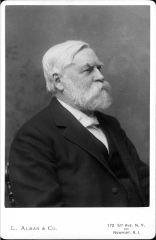in having the State Board of Health send representatives to the campus. The immediate effects of their critical report are difficult to determine beyond the resignation of the janitor and the Board’s choice of a Buildings and Grounds Committee consisting of Dr. Dodge and Professors Spear, Osborn, and Taylor. The latter accepted appointment only on condition that Professor Spear not be allowed to stand in the way of change, an arrangement which was to permit Taylor to begin a notable career as Superintendent of Buildings and Grounds. In fairness to Spear, however, it should be noted that in his years as Treasurer when funds were scarce he had learned to keep expenses to a minimum and any outlay for landscaping he could well regard as of dubious value. It was reluctantly that Dr. Dodge acknowledged the need for improvements and James B. and Samuel Colgate were slow to be won over. The former had been prodded by his son, James C., a sophomore, who called his attention to situations needing correction, many of which were probably not evident when Mr. Colgate made his annual commencement trips to a campus polished and garnished for visitors. One of Taylor’s first moves-arranging for the use of lawn mowers on the area north of East and West Halls-meant that trash had to be removed and some grading done. Competent janitorial service for the dormitories was also instituted. The new dispensation met with enthusiastic student approval, needless to say.
In the fall of 1883 James B. Colgate brought the designer of Central Park in New York and Prospect Park in Brooklyn, the eminent landscape architect, Frederick Law Olmstead, to the campus and they, with President Dodge, and presumably Professor Taylor, spent a day walking over the grounds to locate projected buildings and layout improvements. The celebrated visitor was reported as “quite enthusiastic”
about the picturesque site of the University. No plans drawn up by Olmstead have been found but Taylor acted on some of his recommendations in laying out paths and roads, grading, and planting trees. Students organized by classes contributed a good deal of the labor and for this purpose were given holidays in the spring and fall. Since many had grown up on farms they were not unused to planting or felling trees, digging stumps, or drawing stone. Additional labor came from the Irish immigrants who were being hired as janitors and groundsmen, the best known of whom, Lant Gilmartin, became head janitor in 1888. For many years he was Dr. Taylor’s “right hand man,”
a distinc-







